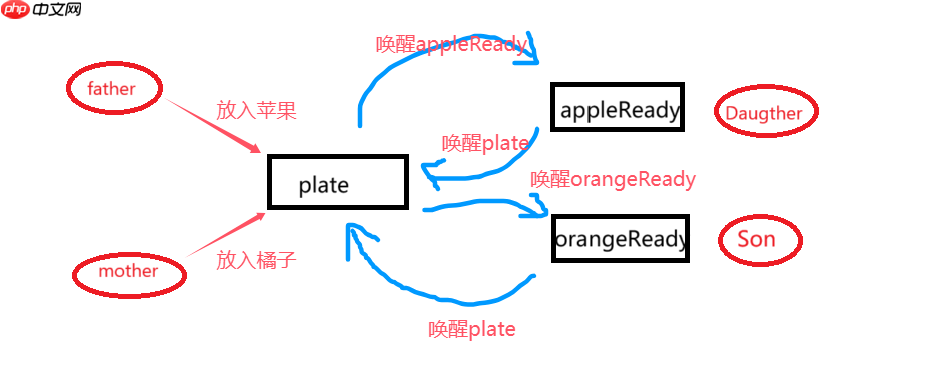在linux环境下,巧妙运用信号量解决水果放取问题,这是一个有趣且实用的多线程同步问题。以下是该问题的思维导图、代码演示和思路解析。

一. 信号量相关实验回顾
二. 巧妙运用信号量解决水果放取问题(思维导图&代码演示&思路解析)
问题描述:一个盘子只能放一个水果,爸爸往里面放苹果,妈妈往里面放橘子,儿子专门等吃橘子,女儿专门等吃苹果。只要盘子空,爸爸或妈妈就可以往里面放水果;仅当盘子里有自己需要的水果时,儿子或女儿才可以取出吃。
设置三个信号量:
- plate:初始值为1,优先执行,面向父母端。
- appleReady:初始值为0,对应女儿等待苹果。
- orangeReady:初始值为0,对应儿子等待橘子。
定义:
- fruitOnPlate:表示盘子中是否有水果。
- fruitType:表示盘子中水果的类型。
- https://www.php.cn/link/93ac0c50dd620dc7b88e5fe05c70e15bdefine APPLE 1 和 https://www.php.cn/link/93ac0c50dd620dc7b88e5fe05c70e15bdefine ORANGE 2:表示水果类型。
信号量操作:
- 信号量等待(P操作):sem_wait()
- 信号量唤醒(V操作):sem_post()

代码语言:C
运行次数:0
https://www.php.cn/link/93ac0c50dd620dc7b88e5fe05c70e15binclude <stdio.h> https://www.php.cn/link/93ac0c50dd620dc7b88e5fe05c70e15binclude <stdlib.h> https://www.php.cn/link/93ac0c50dd620dc7b88e5fe05c70e15binclude <pthread.h> https://www.php.cn/link/93ac0c50dd620dc7b88e5fe05c70e15binclude <semaphore.h> https://www.php.cn/link/93ac0c50dd620dc7b88e5fe05c70e15binclude <unistd.h> https://www.php.cn/link/93ac0c50dd620dc7b88e5fe05c70e15bdefine APPLE 1 https://www.php.cn/link/93ac0c50dd620dc7b88e5fe05c70e15bdefine ORANGE 2 // 表示放入水果 int fruitOnPlate = 0; int fruitType = 0; // 设置信号量 sem_t plate, appleReady, orangeReady; void *father(void *arg) { while (1) { sem_wait(&plate); fruitOnPlate = 1; fruitType = APPLE; // 放入苹果 printf("Father put an apple.n"); sem_post(&appleReady); sleep(rand() % 10); // 睡眠随机时间 } } void *mother(void *arg) { while (1) { sem_wait(&plate); fruitOnPlate = 1; fruitType = ORANGE; // 放入橘子 printf("Mother put an orange.n"); sem_post(&orangeReady); sleep(rand() % 10); // 睡眠随机时间 } } void *son(void *arg) { while (1) { sem_wait(&orangeReady); // 等待橘子 if (fruitType == ORANGE) { printf("Son ate an orange.n"); sem_post(&plate); } } } void *daughter(void *arg) { while (1) { sem_wait(&appleReady); // 等待苹果 if (fruitType == APPLE) { printf("Daughter ate an apple.n"); sem_post(&plate); } } } int main() { pthread_t f_thread, m_thread, son_thread, dau_thread; sem_init(&plate, 0, 1); sem_init(&appleReady, 0, 0); sem_init(&orangeReady, 0, 0); pthread_create(&f_thread, NULL, father, NULL); pthread_create(&m_thread, NULL, mother, NULL); pthread_create(&son_thread, NULL, son, NULL); pthread_create(&dau_thread, NULL, daughter, NULL); pthread_join(f_thread, NULL); pthread_join(m_thread, NULL); pthread_join(son_thread, NULL); pthread_join(dau_thread, NULL); sem_destroy(&plate); sem_destroy(&appleReady); sem_destroy(&orangeReady); return 0; }
通过以上代码,我们可以看到信号量的巧妙运用,确保了水果放取的正确性和同步性。
© 版权声明
文章版权归作者所有,未经允许请勿转载。
THE END



















